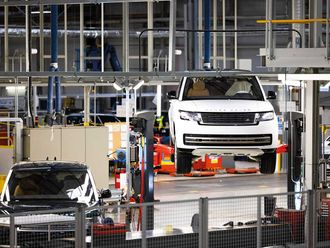
Heavy trucks carrying loads of logs still rumble down Rideau Street, grinding their way through bus lanes and city traffic across the Ottawa River, the icy waters that divide Ontario from Quebec, Ottawa from Hull, English and French-speaking Canada.
It was Queen Victoria in the 1860s who named this small logging town as the capital of her new Dominion of Canada — a compromise to avoid conflict with the English of Upper Canada, who wanted Toronto as the capital, and the French speakers of Lower Canada, who wanted Montreal as the new centre of power.
In such a Canadian way, the Queen named Ottawa, a quiet backwater lumber town as capital, forcing English and French to scurry to their maps and see exactly where the new capital was — compromising with a town out of the way, off the beaten track and suitably removed from both Toronto and Montreal.
Compromise was the watch word in this city for generations. Not anymore.
"It's hard to see Canada compromising on this issue," said a senior UAE official interviewed by Gulf News.
The issue is landing rights, and the compromise needed is to allow both Etihad and Emirates airlines more than the current three landing slots each received per week at Toronto's Pearson Airport. Montreal, Calgary and Vancouver destinations are needed as well as more slots at Pearson, Canada's most expensive airport in terms of landing fees and one of the most expensive for airlines in North America.
Cold wind
The UAE embassy is in a new yellow sandstone complex just off Sussex Drive, the road on which Canada's Prime Minister lives, He's at Number 24. The French ambassador lives next door, and further down the street is the Canadian Mint and the Gothic grey granite of Notre Dame basilica. From his office, the UAE ambassador to Canada, Mohammad Abdullah Al Ghafli, can look out some 200 metres at the Lester Pearson building, a burnt-red brick 1960's monolith that's home to Canada's Department of Foreign Affairs and International Trade. That's where the Foreign Minister, Lawrence Cannon, works. Al Ghafli thinks so, but would know for sure if Cannon would meet him.
Al Ghafli, a former UAE military officer from Al Ain, who spent eight years as Abu Dhabi's No 2 man in Paris, is in Ottawa for the past two years. He has yet to meet Cannon.
In diplomatic terms, two years without a meeting says a lot. And two years of phone calls being answered by Cannon's aides and flunkies says a whole lot more: the politics of Ottawa, once the politics of compromise, are now politics of confrontation.
There's a cold wind blowing from grey skies over the capital, the occasional flurry carried on the air. While it's only 200 metres from the UAE embassy to the Lester Pearson complex, it might as well be a 15-hour direct flight on Emirates or Etihad.
Jobs impact
"The government of Canada have this one wrong," says Professor Joseph D'Cruz at the Rotman School of Business at the University of Toronto. "For whatever reason, the government is listening to Air Canada on this dispute."
For D'Cruz, Air Canada is selling the Ottawa government a bill of goods, and has grossly overstated the impact of its job losses if Emirates and Etihad are given more access to Canadian aviation markets.
"The job losses are very insignificant and Air Canada is wrong when its states that the number of potential losses are in the thousands," he says. Tens, perhaps, certainly not a hundred, much less the thousands trotted out by Air Canada.
"When Air Canada speaks, its not so much speaking on behalf of itself, it's speaking on behalf of the Star Alliance, and certainly on behalf of Lufthansa.
It's the German-based carrier who will lose the most if Emirates and Etihad gain more landing slots, D'Cruz says.
At present, Air Canada funnels most of its passengers for the Middle East, South Asia and Africa into the Star Alliance bases of Frankfurt and Munich. From there Lufthansa flies the passengers onward, and it is they who have the most to lose.
"Emirates and Etihad both have very modern fleets with Airbus A380s and long-range Boeing 777s to make it worthwhile to fly into more Canadian destinations," D'Cruz says. Lufthansa, however, is flying an ageing fleet in need of an upgrade, mostly based on Boeing 747s.
"It's a spurious argument Air Canada is making to the Canadian government and, for some reason, they seem to be buying it." For D'Cruz, the confrontation isn't so much one of protectionism against open skies, but one that shows that the global airline industry is shaking down to legacy carriers and new airlines that have low operating costs.
Unanswered queries
"For Air Canada to suggest that Emirates is state funded isn't correct," D'Cruz says. "The reality is that Emirates, Etihad, or Qatar, Malaysian or Singapore airlines enjoy operating in environment where labour costs are lower and regulation is less. That is the issue: How can Air Canada compete with these carriers?"
How can it? That's hard to answer, because repeated emails to the carrier for comment went unanswered.
Not answering seems to be a tactic regularly used in the new uncompromising Ottawa.
Eleven letters, Gulf News learnt, from the General Civil Aviation Authority in Abu Dhabi to Canadian officials on the issue of landing rights went unanswered. A 12th one was answered — with a reply that asked for more time to discuss the issues.
A copy of a briefing document obtained by Gulf News notes that the issue has been raised by the UAE for the past six years, and so far there has been no concrete action.
Emirates is the largest customer in the world for the new Boeing 777 long-range aircraft. Ironically, some 30 per cent of parts for the aircraft are made in Ontario — everything from landing gear to the storage bins used by passengers.
Just 60km up Highway 417 in the Ottawa Valley, every worker at Arnprior Airspace owes their job to Emirates jet purchases.
Air services agreement
And CAE, the world leader and Montreal-based manufacturer of simulation equipment — technology used to train pilots around the world — will establish the only aviation training facility outside Europe and North America in Dubai.
CAE also partners with Emirates to provide the Flight Training Centre in Dubai, which employees hundreds of Canadians, trains pilots, maintenance technicians and cabin crews for clients in Africa, Asia, Europe, Australia and the Middle East.
That burnt-red brick 1960's monolith on Sussex Drive is also home to Canada's Department of International Trade.
All previous Canadian federal International Trade Ministers in the last five years, as well as all reports from the Department of Foreign Affairs and International Trade, have called on the government of Canada to expand its air services agreements, citing the UAE as prime needs.
No one, it seems, has been able to find Cannon's office to deliver those reports. But Al Ghafli can see the office 200 metres away.
The lights are on, it's just no one is at home.
String of broken promises
Ottawa: The Air Services Agreement (ASA) between the UAE and Canada came into effect on May 28, 1999.
According to a briefing document obtained by Gulf News, the two countries "unfortunately have not met since to update the provisions of the agreement consistent with the current market conditions".
Those market conditions have all six flights per week running at high loading capacity, certainly in excess of 95 per cent. The cargo capacity is at 100 per cent, with the route being so busy, Emirates assigned a an Airbus A380 to the route for the past 18 months.
"For two consecutive years [2006 and 2007] the government of Canada verbally promised the UAE through the Chief Air Negotiator [Mr Nadir Patel at the time] that the Canadian government would be pleased to meet with UAE officials in October — the month was mentioned in both these years — to discuss the Air Services Agreement, but nothing came of these verbal promises," the briefing document says.
The document notes that the UAE government "continues to stress to the Canadian government that they will be pleased for a reciprocal agreement, and welcome Canadian airlines to fly without restrictions into the UAE.
Catalyst: Boost for economy
Emirates airline says that more flights alone between Dubai and Canada could generate $480 million (Dh1.76 billion) in economic activity
Each additional flight from the UAE would inject $60 million annually into the Canadian economy.
UAE passengers spend $10,000 per week per person while on vacation.
Emirates is the largest customer for long-range Boeing 777 aircraft. Almost 30 per cent of all 777 parts are made in Ontario, including landing gear to stowage bins.
Montreal-based CAE, the global leader in aircraft simulation training, has its only training base outside Europe and North America in Dubai.
Investments: Flourishing ties
Taqa investment in Canada's oil and gas sector was $8 billion (Dh29.42 billion) since 2007 and is expected to reach $20 billion in 2012.
DP World has a major investment managing Vancouver Port, Canada's gateway to the Pacific region, and is projected to manage other Atlantic ports.
Alberta and Abu Dhabi Future Energy Company signed a memorandum of understanding on collaboration in carbon capture and storage technology.
Star Alliance
Star Alliance is the world's first and largest airline alliance, headquartered in Germany. Founded in 1997, its five founding airlines were Air Canada, Lufthansa, Scandinavian Airlines, Thai Airways International and United Airlines. Star Alliance has since grown considerably and now has 27 member airlines. The alliance currently has more than 21,200 daily departures to 1,172 airports in 181 countries, with an annual passenger number of 623.5 million.
The CEO of the alliance since 2001 is Jaan Albrecht, who began his aviation career in 1973 as a pilot for Mexicana Airlines.












